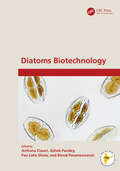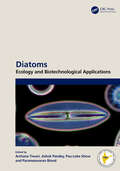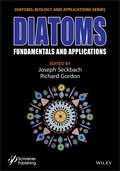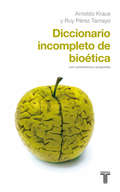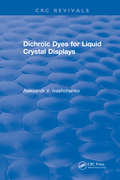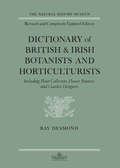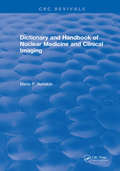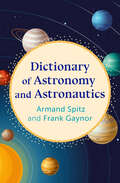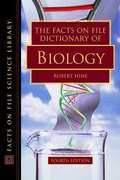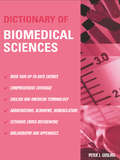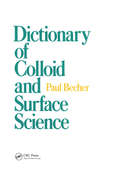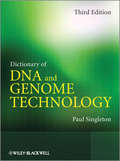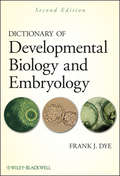- Table View
- List View
Diatom Morphogenesis (Diatoms: Biology and Applications)
by Richard Gordon Vadim Annenkov Joseph SeckbackDIATOM MORPHOGENESIS A unique book presenting the range of silica structures formed by diatoms, theories and hypotheses of how they are made, and applications to nanotechnology by use or imitation of diatom morphogenesis. There are up to 200,000 species of diatoms, each species of these algal cells bearing an ornate, amorphous silica glass shell. The silica is structured at 7 orders of magnitude size range and is thus the most complex multiscalar solid structure known. Recent research is beginning to unravel how a single cell marshals chemical, physical, biochemical, genetic, and cytoskeletal processes to produce these single-cell marvels. The field of diatom nanotechnology is advancing as this understanding matures. Diatoms have been actively studied over the recent 10-20 years with various modern equipment, experimental and computer simulation approaches, including molecular biology, fluorescence-based methods, electron, confocal, and AFM microscopy. This has resulted in a huge amount of information but the key stages of their silica morphogenesis are still not clear. This is the time to reconsider and consolidate the work performed so far and to understand how we can go ahead. The main objective of this book is to describe the actual situation in the science of diatom morphogenesis, to specify the most important unresolved questions, and to present the corresponding hypotheses. The following areas are discussed: A tutorial chapter, with a glossary for newcomers to the field, who are often from outside of biology, let alone phycology; Diatom Morphogenesis: general issues, including symmetry and size issues; Diatom Morphogenesis: simulation, including analytical and numerical methods for description of the diatom valve shape and pore structure; Diatom Morphogenesis: physiology, biochemistry, and applications, including the relationship between taxonomy and physiology, biosilicification hypotheses, and ideas about applications of diatoms. Audience Researchers, scientists, and graduate students in the fields of phycology, general biology, marine sciences, the chemistry of silica, materials science, and ecology.
Diatom Photosynthesis: From Primary Production to High-Value Molecules (Diatoms: Biology and Applications)
by Johann Lavaud Johannes W. Goessling João SerôdioThis comprehensive guide is designed for researchers, professionals, and students looking to deepen their knowledge of diatoms, including detailed information on diatom photosynthesis regulation at the molecular scale, as well as their significant ecological roles, all aimed at promoting sustainable advancements and the safeguarding of aquatic ecosystems. Diatoms exert an immense influence on the ecosystem of Earth due to their remarkable abundance and species diversity. Thriving in diverse habitats spanning the oceans, intertidal benthic zones, saline and freshwater environments, and even terrestrial niches like moist soil, forests, and caves, they play an integral role. Diatoms alone account for around 20% of the oxygen generated by photosynthesis, comparable to the combined productivity of tropical rainforests worldwide, while their primary production can reach 40–45% in marine ecosystems. Nevertheless, in contrast to the extensive research on macroscopic photosynthetic organisms, investigations in this domain remain comparatively limited, despite the role of diatoms in global biogeochemical processes. This book presents an exhaustive review of the subject matter, encompassing a wide spectrum of topics ranging from the intricate molecular mechanisms of diatom photosynthesis and light absorption to the dominant role of diatoms as primary producers within ecological frameworks. Beyond this, the book delves into the practical implications stemming from diatoms and their photosynthetic productivity. A strong emphasis is placed on the importance of fundamental research in deepening our understanding of the natural world around us. Diatoms Photosynthesis provides readers with a comprehensive guide to understanding the fundamentals of diatom photosynthesis and their ecological significance in aquatic ecosystems; a guide to the potential of diatom-derived products for sustainable technologies; a roadmap from diatom photosynthesis to implications in applied sciences; a bridge to span the gap between fundamental research on diatoms and their practical applications. Audience This book caters to academic professionals, students, and researchers in the fields of marine biology, ecology, microbiology, and biochemistry. It offers insights and benefits into diatom photosynthesis, diatom physiology, biodiversity, ecosystem health, and sustainable technological advancements.
Diatoms Biotechnology
by Ashok Pandey Binod Parameswaran Pau Loke Show Archana TiwariThis book covers biotechnology and applications of diatoms including various applications such as the use of diatom biogenic silica in drug delivery and their cultivation for wastewater remediation. It contains case studies in diatom biorefinery and provides information about the bioactive compounds, antioxidants, and lipids from diatoms. It also discusses the latest innovations in the genetic engineering of diatoms. Key Features: Discusses the applications of diatoms in drug delivery Covers the application and cultivation of diatoms for wastewater bioremediation Describes the innovations and gaps in genetic engineering of diatoms Throws light on the lipid content, antioxidant content, and various bioactive compounds present in diatoms Includes extraction technologies in diatoms The book is meant for academicians and microbiologists, biotechnologists, and marine biologists.
Diatoms and Sustainable Agriculture (Sustainable Industrial and Environmental Bioprocesses)
by Archana TiwariThis book highlights the multifaceted role of diatoms in revolutionizing agricultural practices toward sustainability. The introductory chapter of Diatoms and Sustainable Agriculture examines the fundamental role of diatoms in fostering a circular economy within the agricultural sector, discussing the challenges and prospects associated with integrating diatoms into sustainable agricultural practices. Additionally, it reviews the potential of diatoms as natural plant growth promoters, elucidating the mechanisms through which these microorganisms enhance crop productivity while reducing reliance on synthetic fertilizers and pesticides. The chapter also covers the pivotal role of diatoms in agricultural watersheds, serving as indicators of ecosystem health and guiding strategies for maintaining river integrity. Furthermore, the book introduces the potential of diatoms for agricultural wastewater bioremediation and applications of diatom frustules as biosensors for the early detection of plant pathogens. The subsequent chapters explore the current status and future prospects of diatoms as insect control agents, highlighting their potential as environmentally friendly alternatives to conventional pesticides. Toward the end, the text delves into the intersection of artificial intelligence and diatom microalgae-based agriculture. This book serves as an important source for researchers and academicians in phycology, biotechnology, and agricultural sciences.
Diatoms to Dinosaurs: The Size And Scale Of Living Things
by Christopher Mcgowan Julian MulockIn Diatoms to Dinosaurs, Chris McGowan takes the reader on a fascinating journey through the natural world, and examines life in all its various forms. He imparts the excitement of discovery and the joy of understanding as he demonstrates the central importance of size and scale to the survival of living organisms.McGowan investigates a wide range of size-related phenomena, from the gliding mechanism of diatoms to blood pressure problems of dinosaurs. Questions asked -- and answered -- include: Will we ever see giant insects the size of pterodactyls? Why are ants so much stronger relative to body size than elephants? What do a clam, a condor, a tortoise, and a sturgeon have in common? How did the skeleton of a 28-ton Apatosaurus support its weight? How can blood get from the heart to the head of a giraffe without rupturing blood vessels? The author explicates the scientific concepts -- both physical and biological -- needed to inform the relevant phenomena: area/volume relations, metabolism and other basic physiology, kinetic energy, inertial forces, the biology of senescence, boundary layers, and Reynolds numbers. Numerous illustrations scattered throughout the text make the biophysical principles easily comprehensible to readers, regardless of their scientific sophistication.
Diatoms: Ecology and Biotechnological Applications
by Ashok Pandey Parameswaran Binod Archana Tiwari Pau-Loke ShowThis reference book covers the ecological impact and biotechnological applications of diatoms. Diatoms contribute to 40% of primary productivity in aquatic ecosystems. They have a unique biomonitoring ability and sensitivity toward different pollutants in wastewater, and are thereby a tool for ecotoxicological monitoring. The book discusses the need for newer diatom-based indices for wastewater quality analysis. It describes the nutraceutical value of the myriad compounds like omega 3 fatty acids-DHA, polysaccharides, and phenols in diatoms. It also elaborates on the challenges in sustainable diatom biorefinery. This book is meant for microbiologists, biotechnologists, and marine biologists.
Diatoms: Fundamentals and Applications
by Richard Gordon Joseph SeckbachThe aim of this new book series (Diatoms: Biology and Applications) is to provide a comprehensive and reliable source of information on diatom biology and applications. The first book of the series, Diatoms Fundamentals & Applications, is wide ranging, starting with the contributions of amateurs and the beauty of diatoms, to details of how their shells are made, how they bend light to their advantage and ours, and major aspects of their biochemistry (photosynthesis and iron metabolism). The book then delves into the ecology of diatoms living in a wide range of habitats, and look at those few that can kill or harm us. The book concludes with a wide range of applications of diatoms, in forensics, manufacturing, medicine, biofuel and agriculture. The contributors are leading international experts on diatoms. This book is for a wide audience researchers, academics, students, and teachers of biology and related disciplines, written to both act as an introduction to diatoms and to present some of the most advanced research on them.
Diccionario incompleto de bioética
by Arnoldo KrausEl primer diccionario mexicano de bioética. ¿Debe tener límites el conocimiento? ¿Está usted de acuerdo con el concepto de muerte cerebral? ¿Cuándo piensa usted que empieza la vida de un ser humano? ¿Cómo se debería regular el avance tecnológico para evitar sus consecuencias negativas para el ser humano? Este es el primer diccionario mexicano de bioética y surge del deseo de ofrecer al público interesado un marco de referencia que incluya "la mayoría" de los términos relacionados con esta disciplina. Está en evolución porque los límites de su estudio no se han determinado con precisión y porque, a medida que se avanza en ciertos campos de la ciencia, emergen nuevos temas. Arnoldo Kraus y Ruy Pérez Tamayo presentan los conceptos más importantes y controvertidos que se discuten continuamente en relación con la bioética. Pero no sólo explican cada término sino en qué consiste el problema medular y los distintos puntos de vista que se han planteado. Aborto, clonación, confidencialidad, eutanasia, genoma humano, suicidio... están sencilla y brevemente explicados y algunos van acompañados de preguntas para poner al lector, sin rodeos, en el centro de la polémica. "En su sentido más amplio, la bioética se relaciona no sólo con la biología y con la ética sino con muchas otras áreas de la actividad humana, como la medicina, la ecología, la antropología, la economía, la filosofía, las leyes, la ciencia en general, la tecnología y el desarrollo social, entre otras más. Por esta razón nuestro diccionario podría haber sido mucho más amplio, pero entonces debería haberse llamado Diccionario de bioética y de otras cosas, y seguiría siendo incompleto." -Arnoldo Kraus y Ruy Pérez Tamayo.
Dichroic Dyes for Liquid Crystal Displays
by Aleksandr V. IvashchenkoThis book provides a systematic presentation of issues pertaining to the development of dichroic dyes applied in electrooptical systems for displaying and processing data. It explains the theory of the guest-host effect and the methodology of engineering dichroic dye (DD) molecules with specified characteristics. The book then examines the properties of currently known DDs, including the most interesting examples of synthesis. Various aspects of designing LCM for guest-host devices and available designs of guest-host LCDs are considered as well. Characteristics of dichroic dyes are presented in the Appendix as an added benefit to readers.
Dicotyledons: Rosids (Illustrated Handbook of Succulent Plants)
by Urs Eggli Reto NyffelerThe succulent species of the families of subclass Rosidae are presented by alphabet of families, genera, and species, with comprehensive listings of synonyms added at all levels. Detailed descriptions are given for all accepted taxa, together with data on the distribution and typification, and references to the most important literature. Where necessary, information on ecology, ethnobotany, history, etc. is added, and in many places, proposed relationships are critically discussed.The volume covers the succulents from the families Anacardiacae, Begoniaceae, Bixaceae, Brassicaceae, Burseraceae, Capparaceae, Caricaceae, Clusiaceae, Cucurbitaceae, Euphorbiaceae, Fabaceae, Francoaceae, Geraniaceae, Malvaceae, Melastomataceae, Meliaceae, Moraceae, Moringaceae, Oxalidaceae, Passifloraceae, Sapindaceae, Tropaeolaceae, Urticaceae, Vitaceae and Zygophyllaceae.
Dictionary Of British And Irish Botantists And Horticulturalists Including plant collectors, flower painters and garden designers: Including Plant Collectors, Flower Painter And Garden Designer
by Ray DesmondOver the past four centuries botanists and gardeners in the British Isles have gathered, maintained and propagated many varying species of plants. Their work has been documented in innumerable books and articles which are often difficult to trace. The Dictionary of British and Irish Botanists and Horticulturalists represents a time-saving reference source for those who wish to discover more about the lives and achievements of the horticulturalists listed. The dictionary's utility comes not only from indicating the major publications of the named authors, but also the location of their herbaria and manuscripts.; The previous 1977 edition of the Dictionary has for many years been a much used source of information for botanists, botanic artists and archivists. In this revised edition the scope has been expanded to include among its 13,000 entries flower painters in addition to botanical artists over 1400 entries and, for the first time, garden designers.; Finally the Dictionary should have international appeal since so many botanists and gardeners worked on collective plants overseas, in particular in North America and the British Commonwealth.; Each entry gives, wherever possible, details of dates and places of birth and death, educational qualifications, professional posts, honours and awards, publications, location of plant collections, manuscripts, drawings and portraits. Its main function, however, is to provide further biographical references to books and periodicals. Comprehensive classified indices facilitate access by professions and activities, countries, and plant interests.
Dictionary Organic Compounds, Sixth Edition, Supplement 2
by Fiona Macdonald John BuckinghamThis book includes over 2,500 entries of organic compounds, some of which cover recently synthesized molecules of research interest, while others refer to known compounds which have come into prominence. It is an invaluable resource for Organic and Pharmaceutical chemists.
Dictionary and Handbook of Nuclear Medicine and Clinical Imaging
by Mario P. IturraldeThis impressive dictionary/handbook presents the nomenclature characteristic of nuclear medicine, explaining the meaning and current usage of a large variety of terms. It is designed as a ready-to-use and simple guide, arranged in alphabetical order with additional basic information assembled in the appendices. The single volume offers a look into the multidisciplinary world of this specialty. The field of nuclear medicine has emerged as an integrated medical discipline. It is an example of the convergence of many scientific disciplines with those of medicine emphasizing the use of radionuclides in research, diagnosis and therapy. The dictionary/handbook will be of importance to individuals in nuclear medicine and the following fields: physics, instrumentation, techniques, computers, radiopharmacology and radiopharmacy, radioimmunoassay, radiobiology and radiation protection, quality control, math and statistics, nuclear science and technology, radiology, ultrasound, and nuclear magnetic resonance.
Dictionary of Alkaloids
by John Buckingham Andrew D. Roberts Keith H. Baggaley László F. SzabóWhile some of the most commonly investigated- and most notorious- chemicals in the world are alkaloids, many modern medicines are also based on alkaloid structures. Chemists continue to explore new synthetic routes and alkaloid derivatives in search of drug candidates for fighting disease. Drawn from the venerable Dictionary of Natural Products, th
Dictionary of Antibiotics and Related Substances: Second Edition
by Barrie W. Bycroft David J. PayneBacterial and parasitic diseases are the second leading cause of death worldwide, according to a report by the London School of Economics. Due to the emergence of drug-resistant "superbugs," like methicillin-resistant Staphylococcus aureus (MRSA), traditional antibiotics such as penicillin and its derivatives are in danger of becoming obsolete. In an effort to combat this problem, pharmaceutical companies continue to research new and effective antibiotics.The Dictionary of Antibiotics and Related Substances, Second Edition is a definitive reference work dealing with this crucially important class of biochemicals. It consists of a comprehensive survey of the antibiotic field, providing a single-volume resource and a significant update to the first edition published in 1988. Each dictionary entry contains the chemical name and synonyms, CAS Number, chemical structure, biological activity, and a concise bibliography.Entries include naturally occurring antibiotics, such as the beta-lactams (penicillins, cephalosporins, and carbapenems) and aminoglycosides; semisynthetic antibiotics—the most common type available—modified chemically from original compounds found in nature; and synthetic antibiotics, including the sulfonamides, the quinolones, and the oxazolidinones. It is estimated that there are approximately 10,000 antibiotics known, and this revised edition of the successful compilation covers all of the different classes. The dictionary also includes fully searchable downloadable resources.
Dictionary of Astronomy and Astronautics
by Frank Gaynor Armand SpitzThis authoritative reference volume features more than 2,200 terms and concepts covering a wide array of topics in astronomy and astronautics. This in-depth overview of important terms and concepts in the fields of astronomy and astronautics is designed to be an authoritative and easy-to-use reference book. With thousands of entries arranged alphabetically, it provides ready answers for students of space science as well as the curious reader. From &“Aberration of Light&” and &“Abnormal Stars&” to &“Zodiacal Light&” and &“Zone Time&”, this comprehensive volume provides a wealth of fascinating information.
Dictionary of Biology
by Bill IndgeThis Dictionary provides an explanation of the main ideas of and concepts central to biology. Rather than offer an exhaustive list of technical terms, the author has selected a range of basic terms that are likely to meet the needs of most readers and librarians. The entries cover not only the traditional subject areas but also many of the topics that form the distinctive parts of human and social biology. Each entry in the Dictionary of Biology begins with a clear, one-sentence definition, followed by a further explanation, and, where appropriate, by specific examples. Numerical ideas are supported by working examples. Entries are cross-referenced, and the A-Z arrangement makes the book very easy to use.
Dictionary of Biology (4th edition)
by Robert HineAimed at high school students, this reference defines the basic principles and terms used in the field of biology. Approximately 300 new entries have been added to this fourth edition, including entries on beta-oxidation, cerebral nuclei, DNA fingerprinting, and rapid eye movement. Pronunciation symbols and new line illustrations have also been added. The appendices include charts of the animal and plant kingdoms and amino acids, as well as a list of online resources.
Dictionary of Biomedical Science
by Peter J. GoslingDo you want to know what inherited defect causes thalassaemia? Do you understand the significance of "resistance" when applied to microbiology? Can you say what a "frozen section" really is? The Dictionary of Biomedical Sciences answers all these questions and more. This informative, practical guide contains over 8000 entries that define all the ba
Dictionary of Carbohydrates
by Peter M. CollinsAn easy-to-use reference source for all scientists working with carbohydrates, the Dictionary of Carbohydrates with CD-ROM, Second Edition builds on the success of its previous edition by providing a substantially increased number of compounds. The presentation is sharpened by a careful review of existing entries. With 24,000 compounds, it represen
Dictionary of Christianity and Science: The Definitive Reference for the Intersection of Christian Faith and Contemporary Science
by Tremper Longman III Christopher L. Reese Michael Strauss Paul CopanThe Dictionary of Christianity and Science provides, in one volume, entries on over 450 key terms, theories, individuals, movements, and debates at the intersection of Christian faith and contemporary science. In addition, because certain topics such as the age of the Earth and the historicity of Adam and Eve provoke disagreement among Christians, the dictionary includes “Counterpoints”-like essays that advocate for the views most commonly held among evangelicals. Representatives of leading perspectives present their arguments vigorously but respectfully in these advocacy essays, allowing readers to compare options and draw their own conclusions. The dictionary is also fully cross-referenced and entries include references and recommendation for further reading. Edited by Paul Copan, Tremper Longman III, Christopher L. Reese, and Michael G. Strauss, the Dictionary of Christianity and Science features a top-notch lineup of over 140 contributors in the fields of biblical studies, theology, philosophy, history, and various sciences. A unique reference work, it will be useful for scholars, pastors, students, and any Christian wanting to better understand the most relevant issues and ideas at the intersection of Christian faith and science.
Dictionary of Colloid and Surface Science
by Paul BecherThis book is a mini-encyclopedia providing a wealth of information on all aspects of colloid and surface science, including historical background information, insights into the implications of definitions, biographical notes, and sketches of scientists who have contributed to the field.
Dictionary of DNA and Genome Technology
by Paul SingletonDNA technology is evolving rapidly, with new methods and a fast-growing vocabulary. This unique dictionary offers current, detailed and accessible information on DNA technology to lecturers, researchers and students throughout the biomedical and related sciences.The third edition is a major update, with over 3000 references from mainstream journals and data from the very latest research - going well beyond the remit of most science dictionaries. It provides clear explanations of terms, techniques, and tests, including commercial systems, with detailed coverage of many important procedures and methods, and includes essay-style entries on many major topics to assist newcomers to the field. It covers topics relevant to medicine (diagnosis, genetic disorders, gene therapy); veterinary science; biotechnology; biochemistry; pharmaceutical science/drug development; molecular biology; microbiology; epidemiology; genomics; environmental science; plant science/agriculture; taxonomy; and forensic science.
Dictionary of Developmental Biology and Embryology
by Frank J. DyeA newly revised edition of the standard reference for the field today—updated with new terms, major discoveries, significant scientists, and illustrations Developmental biology is the study of the mechanisms of development, differentiation, and growth in animals and plants at the molecular, cellular, and genetic levels. The discipline has gained prominence in part due to new interdisciplinary approaches and advances in technology, which have led to the rapid emergence of new concepts and words. The Dictionary of Developmental Biology and Embryology, Second Edition is the first comprehensive reference focused on the field's terms, research, history, and people. This authoritative A-to-Z resource covers classical morphological and cytological terms along with those from modern genetics and molecular biology. Extensively cross-referenced, the Dictionary includes definitions of terms, explanations of concepts, and biographies of historical figures. Comparative aspects are described in order to provide a sense of the evolution of structures, and topics range from fundamental terminology, germ layers, and induction to RNAi, evo-devo, stem cell differentiation, and more. Readers will find such features of embryology and developmental biology as: Vertebrates Invertebrates Plants Developmental genetics Evolutionary developmental biology Molecular developmental biology Medical embryology The author's premium on accessibility allows readers at all levels to enhance their vocabulary in their field and understand terminology beyond their specific focus. Researchers and students in developmental biology, cell biology, developmental genetics, and embryology will find the dictionary to be a vital resource.


